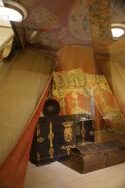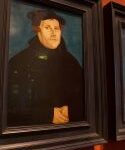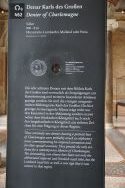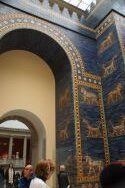March 18, 2018
If you’re thinking our trip was mostly museums and palaces, it’s even less diversified than it sounds; most of the palaces, no longer occupied by Hohenzollerns, ARE museums. And that was even true of our last night’s visit to Charlottenburg, the palace built in what was then the outskirts of the city (the far side of the hunting park -today the Tiergarten) that extends west from the Brandenburg Gate. The palace, the largest in what is now Berlin, was built originally in the late 17th century by one of the Fredericks (or Williams; or Frederick Williams—the Hohenzollerns tended to one of other, or both names) for his wife, Sophie Charlotte. The dome of the palace can be seen for miles, and the 
 gate to the city (now district) of Charlottenburg rivals the Brandenburg Gate. The palace grounds are also well worth a visit, though, as is typical of much of Berlin, major parts of the palace were rebuilt after being bombed in World War II.
gate to the city (now district) of Charlottenburg rivals the Brandenburg Gate. The palace grounds are also well worth a visit, though, as is typical of much of Berlin, major parts of the palace were rebuilt after being bombed in World War II.
Anyway, we had dinner in the palace, followed by a concert in the Orangerie, a room that was probably where the Frederick/Williams of the world held their chamber music concerts for guests. The sound (and setting) made it clear that this is how one should listen to chamber music, such as the Vivaldi/Handel concert we heard. The musicians were in period costume, though the white wigs clashed (for me) with their black beards. The room was cold, and I suspect many of the palaces were heated by fireplace, a room at a time. Even the royals had to figure out how to stay warm in the cold here (it was 20 last night, and windy, a fact brought home as we sought a cab to get back to the hotel).
And the museums proper are well worth the visits. A new one for me was the German History Museum; the original building was the 
 Prussian Arsenal, and given the size of Prussia’s armies, large enough to encompass a collection that starts in the late 700s, when Karl die Grosse, who you probably know better as Charlemagne, unified France and Germany, inaugurating the Holy Roman Empire with his coronation by the pope in Aux-la-Chapelle Christmas Day 800. The highlights of the collection for me were an extensive look at the man who brought reform to the church (Luther), and what is still the predominant religion
Prussian Arsenal, and given the size of Prussia’s armies, large enough to encompass a collection that starts in the late 700s, when Karl die Grosse, who you probably know better as Charlemagne, unified France and Germany, inaugurating the Holy Roman Empire with his coronation by the pope in Aux-la-Chapelle Christmas Day 800. The highlights of the collection for me were an extensive look at the man who brought reform to the church (Luther), and what is still the predominant religion 
 (Lutheranism) to Germany; the hat and sword Napoleon left at Waterloo, fleeing when General Blucher, commanding the Prussian army, joined Wellington to turn the tide of battle; and—stunningly, a tent captured from the Ottomans at the siege of Vienna in 1683. The last-named item somehow found its way to Kaiser Wilhelm and thence into the collection at the Museum.
(Lutheranism) to Germany; the hat and sword Napoleon left at Waterloo, fleeing when General Blucher, commanding the Prussian army, joined Wellington to turn the tide of battle; and—stunningly, a tent captured from the Ottomans at the siege of Vienna in 1683. The last-named item somehow found its way to Kaiser Wilhelm and thence into the collection at the Museum.
The Kaiser’s well-known end of the century flirtation with Sultan Abdul-Hamid, of Turkey, was a fatal dance politically, leading to the Ottoman’s joining (not entirely voluntarily) with the Central Powers, extending World War I to the Middle East and creating the chaos that  endures till this day. I think this is around Anzac Day, an Australian-New Zealand holiday that commemorates the bloody battles at Gallipoli.
endures till this day. I think this is around Anzac Day, an Australian-New Zealand holiday that commemorates the bloody battles at Gallipoli.
The flirtation had a more salutary effect (if you don’t mind that many of the artifacts wound up in Berlin) on archaeology; the Pergamon museum, even in its state of being rehabilitated, is stunning. When you go thru the gates of Ishtar, you’re transported to Scheherazade, with lions and other mosaics stretching for a block in the museum; a stunning partial fortress of some long-lost and otherwise forgotten caliph in the deserts; and a whole floor of Islamic Art that rivals anything in the world, with items from Istanbul, and Konya, and Agra, and Moorish Spain, and….The Neues Museum (mostly Egyptian) houses the famous Nefertiti bust, the Mona Lisa equivalent of the ancient world as the standard of beauty. No wonder we spent four and a half hours on the Museum Island at these two museums—and there were three more!
transported to Scheherazade, with lions and other mosaics stretching for a block in the museum; a stunning partial fortress of some long-lost and otherwise forgotten caliph in the deserts; and a whole floor of Islamic Art that rivals anything in the world, with items from Istanbul, and Konya, and Agra, and Moorish Spain, and….The Neues Museum (mostly Egyptian) houses the famous Nefertiti bust, the Mona Lisa equivalent of the ancient world as the standard of beauty. No wonder we spent four and a half hours on the Museum Island at these two museums—and there were three more!
The archaeologists played an interesting part in the dance the Kaiser made that drew the Ottomans into the Central Powers. His goal during the war was to incite a jihad, especially against the British and French (can you say India? The Suez Canal? Lawrence of Arabia?), which would have been quite a trick to make it national rather than religious. There’s an interesting book on the Berlin-Baghdad railroad, which was pivotal to the German war aims—and vital in bringing the artifacts back to Berlin.
We’re awaiting our flight home right now, which is to say, our plans are almost up in the air. Back home in “only” 18 hours-flight connections willing.